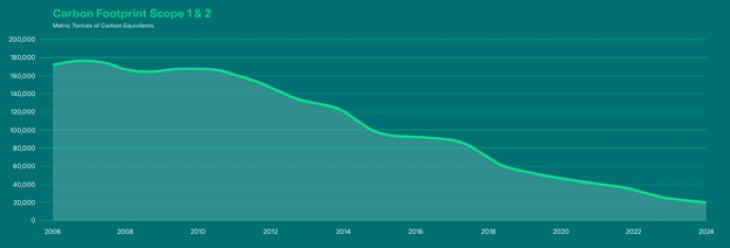
Climate change and carbon emissions
In 2006, we set a target to reduce our Scope 1 and 2 greenhouse gas (GHG) emissions by 75% by 2026. We accomplished this goal in 2021 – demonstrating our commitment by setting ambitious goals and taking action to shrink our carbon footprint.
Because we accomplished our previous goal, in 2022 we set a new target to achieve net zero GHG emissions for Scope 1 and 2 sources by 2030 as compared to our baseline year of 2020 (the Net Zero Goal)(1). This target received validation from SBTi in March 2023(2). We see SBTi validation as an important stamp of independent assurance that this near-term target is credible, anchored in sound science, and aligned with the Paris Climate Agreement’s goal of limiting global temperature increase to 1.5°C.
1 For purposes of this 2023 Sustainability Report, we define “net zero” as the state achieved when our anthropogenic Scope 1 and 2 GHG emissions to the atmosphere are balanced by anthropogenic removals. Our definition of net zero and our Net Zero Goal are limited to our Scope 1 and 2 GHG emissions sources. Our Net Zero Goal is not validated in connection with the Science Based Targets Initiative’s Corporate Net-Zero Standard or classified as a “net zero” target by the Science Based Targets initiative. Carbon offsets may be used here in addition to standard emissions reductions to obtain net zero emissions by 2030.
2 SBTi deemed this target to conform with SBTi Criteria and Recommendations (version 4.2). This target was not validated in connection with SBTi’s Corporate Net-Zero Standard or classified as a “net zero” target by SBTi.
Our journey to net zero
Our journey to net zero is specific to Scope 1 and Scope 2 GHG emissions. Through 2023 we have already reduced our aggregated Scope 1 and Scope 2 GHG emissions by over 50% as compared to our baseline year.3

While our priority is to reduce our Scope 1 and 2 GHG emissions, we also intend to explore viable options to address residual, harder-to abate Scope 1 and 2 emissions. These include potential technological developments or tools such as renewable energy credits (to address Scope 2 emissions) and carbon credits (to support climate mitigation activities beyond our value chain).
3 ISOS Group, Inc. (ISOS) has provided independent assurance of the energy consumption, Scope 1 and Scope 2 GHG emissions, and Scope 2 GHG emissions data in this report. GHG emissions were calculated using the operational control methodology specified in the GHG Protocol. Several smaller Scope 1 GHG emissions sources (e.g., refrigerant releases and mobile combustion sources) were excluded from ISOS’s review.

Leadership’s endorsement of our goal to reach net zero Scope 1 and Scope 2 GHG emissions by 2030 is a new milestone for Unisys. We hit our previous GHG emissions reduction target five years ahead of schedule, and now we’re scaling up our ambition.
Director of Global Environmental, Health, Safety and Security, Unisys
How we’re reducing our emissions
Five actions that enabled us to meet our previous target that will help us take aim at the next one.
1 - Innovating and deploying solutions that reduce our carbon footprint and those of our clients through our products and services
Our Digital Workplace Solutions are designed to optimize remote work; our Cloud Applications & Infrastructure and Enterprise Computing Solutions offer agility and efficiency and unlock innovation.
2 - Optimizing our real estate footprint
In the past five years, our real estate square footage has been reduced globally by about 25%.
3 - Reducing air and vehicle travel
GHG emissions per headcount in 2023 have been reduced by approximately 14% as compared to 2019.
4 - Increasing energy efficiency
Since 2019, our power consumption has been reduced globally by about 47%.
5 - Procuring renewable power
In 2023 use of renewable power at our Salt Lake City Data Center resulted in a reduction of approximately 4,000,000 kWh and over 1,400 metric tonnes of Scope 2 GHG emissions. In Hyderabad, India - We procured renewable power that reduced Scope 2 GHG emissions by over 200 metric tonnes.
These efforts in reducing emissions have led us to a 56% emissions reduction in just 5 years.